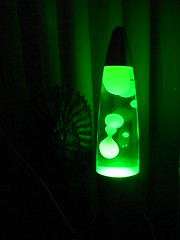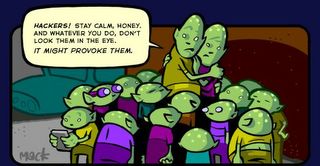Monday, January 31, 2005
Friday, January 28, 2005
ANIMARIS RHINOCEROS TRANSPORT

The Animaris Rhinoceros Transport is a type of animal with a steel skeleton and a polyester skin. It looks as if there is a thick layer of sand coating the animal. It weighes 2. tons, but can be set into motion by one person. It stands 4.70 meters tall. Because of its height it catches enough wind to start moving.
http://www.strandbeest.com/
Posted by
Glenn
at
1:00 pm
0
comments
![]()
Thursday, January 27, 2005
Animal-Human Hybrids Spark Controversy
Scientists have begun blurring the line between human and animal by producing chimeras—a hybrid creature that's part human, part animal.
Chinese scientists at the Shanghai Second Medical University in 2003 successfully fused human cells with rabbit eggs. The embryos were reportedly the first human-animal chimeras successfully created. They were allowed to develop for several days in a laboratory dish before the scientists destroyed the embryos to harvest their stem cells.
In Minnesota last year researchers at the Mayo Clinic created pigs with human blood flowing through their bodies.
And at Stanford University in California an experiment might be done later this year to create mice with human brains.
Scientists feel that, the more humanlike the animal, the better research model it makes for testing drugs or possibly growing "spare parts," such as livers, to transplant into humans.
Watching how human cells mature and interact in a living creature may also lead to the discoveries of new medical treatments.
But creating human-animal chimeras—named after a monster in Greek mythology that had a lion's head, goat's body, and serpent's tail—has raised troubling questions: What new subhuman combination should be produced and for what purpose? At what point would it be considered human? And what rights, if any, should it have?
There are currently no U.S. federal laws that address these issues.
Ethical Guidelines
The National Academy of Sciences, which advises the U.S. government, has been studying the issue. In March it plans to present voluntary ethical guidelines for researchers.
A chimera is a mixture of two or more species in one body. Not all are considered troubling, though.
For example, faulty human heart valves are routinely replaced with ones taken from cows and pigs. The surgery—which makes the recipient a human-animal chimera—is widely accepted. And for years scientists have added human genes to bacteria and farm animals.
What's caused the uproar is the mixing of human stem cells with embryonic animals to create new species.
Biotechnology activist Jeremy Rifkin is opposed to crossing species boundaries, because he believes animals have the right to exist without being tampered with or crossed with another species.
He concedes that these studies would lead to some medical breakthroughs. Still, they should not be done.
"There are other ways to advance medicine and human health besides going out into the strange, brave new world of chimeric animals," Rifkin said, adding that sophisticated computer models can substitute for experimentation on live animals.
"One doesn't have to be religious or into animal rights to think this doesn't make sense," he continued. "It's the scientists who want to do this. They've now gone over the edge into the pathological domain."
David Magnus, director of the Stanford Center for Biomedical Ethics at Stanford University, believes the real worry is whether or not chimeras will be put to uses that are problematic, risky, or dangerous.
Human Born to Mice Parents?
For example, an experiment that would raise concerns, he said, is genetically engineering mice to produce human sperm and eggs, then doing in vitro fertilization to produce a child whose parents are a pair of mice.
"Most people would find that problematic," Magnus said, "but those uses are bizarre and not, to the best of my knowledge, anything that anybody is remotely contemplating. Most uses of chimeras are actually much more relevant to practical concerns."
Last year Canada passed the Assisted Human Reproduction Act, which bans chimeras. Specifically, it prohibits transferring a nonhuman cell into a human embryo and putting human cells into a nonhuman embryo.
Cynthia Cohen is a member of Canada's Stem Cell Oversight Committee, which oversees research protocols to ensure they are in accordance with the new guidelines.
She believes a ban should also be put into place in the U.S.
Creating chimeras, she said, by mixing human and animal gametes (sperms and eggs) or transferring reproductive cells, diminishes human dignity.
"It would deny that there is something distinctive and valuable about human beings that ought to be honored and protected," said Cohen, who is also the senior research fellow at Georgetown University's Kennedy Institute of Ethics in Washington, D.C.
But, she noted, the wording on such a ban needs to be developed carefully. It shouldn't outlaw ethical and legitimate experiments—such as transferring a limited number of adult human stem cells into animal embryos in order to learn how they proliferate and grow during the prenatal period.
Irv Weissman, director of Stanford University's Institute of Cancer/Stem Cell Biology and Medicine in California, is against a ban in the United States.
"Anybody who puts their own moral guidance in the way of this biomedical science, where they want to impose their will—not just be part of an argument—if that leads to a ban or moratorium. … they are stopping research that would save human lives," he said.
Mice With Human Brains
Weissman has already created mice with brains that are about one percent human.
Later this year he may conduct another experiment where the mice have 100 percent human brains. This would be done, he said, by injecting human neurons into the brains of embryonic mice.
Before being born, the mice would be killed and dissected to see if the architecture of a human brain had formed. If it did, he'd look for traces of human cognitive behavior.
Weissman said he's not a mad scientist trying to create a human in an animal body. He hopes the experiment leads to a better understanding of how the brain works, which would be useful in treating diseases like Alzheimer's or Parkinson's disease.
The test has not yet begun. Weissman is waiting to read the National Academy's report, due out in March.
William Cheshire, associate professor of neurology at the Mayo Clinic's Jacksonville, Florida, branch, feels that combining human and animal neurons is problematic.
"This is unexplored biologic territory," he said. "Whatever moral threshold of human neural development we might choose to set as the limit for such an experiment, there would be a considerable risk of exceeding that limit before it could be recognized."
Cheshire supports research that combines human and animal cells to study cellular function. As an undergraduate he participated in research that fused human and mouse cells.
But where he draws the ethical line is on research that would destroy a human embryo to obtain cells, or research that would create an organism that is partly human and partly animal.
"We must be cautious not to violate the integrity of humanity or of animal life over which we have a stewardship responsibility," said Cheshire, a member of Christian Medical and Dental Associations. "Research projects that create human-animal chimeras risk disturbing fragile ecosystems, endanger health, and affront species integrity."
Posted by
Glenn
at
4:46 pm
0
comments
![]()
|
| |
 | High-Tech Spacesuits Eyed for ‘Extreme Exploration’
|
CAMBRIDGE, Mass. -- Future explorers on the Moon and Mars could be outfitted in lightweight, high-tech spacesuits that offer far more flexibility than the bulky suits that have been used for spacewalks in the 1960s.
Research is under way at the Massachusetts Institute of Technology (MIT) on a Bio-Suit System that incorporates a suit designed to augment a person’s biological skin by providing mechanical counter-pressure. The “epidermis” of such a second skin could be applied in spray-on fashion in the form of an organic, biodegradable layer.
This coating would protect an astronaut conducting a spacewalk in extremely dusty planetary environments. Incorporated into that second skin would be electrically actuated artificial muscle fibers to enhance human strength and stamina.
The Bio-Suit System could embody communications equipment, biosensors, computers, even climbing gear for spacewalks or what NASA calls an Extra Vehicular Activity (EVA).
“When we get back to the Moon and on Mars, we’re not going there to stay in a habitat,” said Dava Newman, professor in the Department of Aeronautics and Astronautics and Engineering Systems here at MIT. “EVA becomes … a primary function,” she said.
Newman is leading the Bio-Suit System work, assisted by researchers Kristen Bethke, Christopher Carr, Nicole Jordan, and Liang Sim in the Department of Aeronautics and Astronautics and Engineering Systems. The study is multi-pronged and is intended to better calibrate astronaut performance, explore improvements to current spacesuit designs and generate novel ideas for a new generation of space exploration suits.
The NASA Institute for Advanced Concepts, headquartered in Atlanta, is sponsoring the Bio-Suit System effort.
“We need to shrink-wrap the astronaut,” Newman said. “It would be like wearing a second skin.”
The Bio-Suit System, Newman said, would provide life support through mechanical counter pressure where pressure is applied to the entire body through a tight-fitting suit with a pressurized helmet for the head. Ongoing research is targeted at understanding, simulating, and predicting capabilities of suited astronauts in a variety of scenarios — be they performing simple motions or more complex movement, such as overhead or cross-body reach, stepping up, or trudging across an exotic landscape.
The scenario envisioned by Newman and her associates is an astronaut first donning his or her customized elastic Bio-Suit layer. Then a hard torso shell would be slipped on, sealed via couplings located at the hips. A portable life support system is then attached mechanically to the hard torso shell and provides gas counter pressure. Gas pressure would flow freely into the wearer’s helmet and down tubes on the bio-suit layer to the gloves and boots.
Newman said that the spacesuits of today are very limited in terms of mobility. In addition, the current weight or mass of EVA suits is another limiting factor.
“In the microgravity environment those limitations are not show-stoppers. But for an advanced exploration spacesuit for the Moon or Mars, unlimited mobility and a very low mass spacesuit are paramount,” Newman told SPACE.com .
There are several advances in technology that Newman and her MIT colleagues consider key in turning their work into a practical, suitable suit for human space explorers.
“We’re looking into cutting edge materials, development and modeling capabilities to turn our Bio-Suit concepts in to working prototypes implementing mechanical counter-pressure,” Newman advised.
Newman said Bio-Suit relies on advances in fabrication and application of open cell foam, smart materials like advanced “muscle wire” technologies, and electrospinlacing. “All of these have seen vast improvements in the last few years,” she said.
The MIT group has investigated unique modeling techniques, such as taking 3D laser scans of a person. Then, using mathematical modeling and mechanics techniques, a “stress-strain field calculation” is performed for the entire human body.
“The modeling allows us to prescribe a minimum energy suit that literally could be ‘painted on’ to provide maximum mobility for extreme exploration required on the Moon or Mars,” Newman said.
Lightweight and easy to don and doff, the bio-suit layer would be custom fitted to each astronaut — made possible by a laser scanning/electrospinlacing process. That method stems from work at the U.S. Army Soldier Systems Center in Natick, Mass. where researchers there are tapping into science and technology for 21st century combat uniforms, as well as police officer garb able to thwart chemical or biological agents.
In addition, the MIT Bio-Suit System team is working with Midé Technology Corp. of Medford, Mass. to adopt such items as micro-actuators and smart (active) materials in their designs.
Among other collaborations, Bio-Suit System researchers are also drawing upon the Institute for Soldier Nanotechnologies, an interdepartmental research center at MIT. The ultimate goal of that institute is to create a 21st century battlesuit that combines high-tech capabilities with light weight and comfort.
“The roadmap that the president and NASA have established involves spiral development and multiple destinations and operating environments over a relatively short period of time. With the very real budget pressures we will all face, I think the most critical element for success will be the early creation of an effective, modular EVA system architecture,” said Edward Hodgson, a Technical Fellow at Hamilton Sundstrand Space Systems International in Windsor Locks, Conn.
Hodgson said an evolutionary approach will permit changes in response to altering mission needs, and also to infuse new technology as it develops with a minimum of system level redesign and recertification.
Hodgson has also received support from the NASA Institute for Advanced Concepts to study a “Chameleon Suit.” The name reflects the fact that walls of the suit change in response to variations in the environment or in the wearer’s need for cooling.
The ultimate goal of this concept is a symbiotic interaction of astronaut and spacesuit like that between humans and terrestrial plants in which the astronaut’s waste carbon dioxide and water vapor are converted back into respirable oxygen in the suit walls using environmental energy sources.
Technologies under study, Hodgson noted, include shape change polymers and electro-emissive materials to modify heat transfer characteristics of the spacesuit skin so it is similar to that found in natural biological systems.
from Space.com
Posted by
Glenn
at
1:31 pm
0
comments
![]()
Mobile virus infects Lexus cars
Lexus cars may be vulnerable to viruses that infect them via mobile phones. Landcruiser 100 models LX470 and LS430 have been discovered with infected operating systems that transfer within a range of 15 feet.
"If infected mobile devices are scary, just thinking about an infected onboard computer..," said Eugene Kaspersky, head of anti-virus research at Russian firm Kaspersky. "We do know that car manufacturers are integrating existing operating systems into their onboard computers (take the Fiat and Microsoft deal, for instance)."
It is understood the virus could affect the navigation system of the Lexus models, it transfers onto them via a Bluetooth mobile phone connection. It is still unclear whether the cars in question use the Symbian operating system which has recently been under attack from various worms and viruses.
"At this stage it's still early but it just goes to show that technology has consequences," said David Emm, senior technology consultant at Kaspersky. "It's scary stuff."
Vulnerable operating systems are increasingly moving onto a number of different devices. Last year the Slammer worm infected 13,000 Bank of America ATMs as a result of them moving to a Windows-based operating system.
"I've even seen screenshots of major commercial aeroplanes with Windows 2000-based operating systems," said Mikko Hypponen, director of anti-virus research at Finnish firm F-Secure. "Cars are an obvious target for viruses. It's okay if you don't use the operating system for the engine and the brakes, but when you do..."
Bill Gates is a known Lexus driver. In 1999 he auctioned one for charity.
When contacted Lexus declined to comment.
Posted by
Glenn
at
9:13 am
0
comments
![]()
Wednesday, January 26, 2005
Ringo to the rescue
 Yellow Submarine and (right) as himself in the The Beatles TV cartoon." align="middle" height="302" width="430">
Yellow Submarine and (right) as himself in the The Beatles TV cartoon." align="middle" height="302" width="430">Animated character ... Ringo (left) as himself in Yellow Submarine and (right) as himself in the The Beatles TV cartoon.
Former Beatles drummer Ringo Starr has joined forces with Stan Lee's POW! Entertainment group to develop a franchise in which Starr will play an animated superhero version of himself.
Starr's character will be an evil-battling, earth-saving, albeit reluctant superhero with a great sense of rhythm.
This will be Starr's third major comic character persona following on from the American Broadcasting Corporation's 1965-67 cartoon series The Beatles and the animated 1968 feature Yellow Submarine.
This time, however, Starr will voice his own character as he did when his cartoon self made a guest appearance on a 1991 episode of The Simpsons.
"He's a great, great guy to work with. He's a real guy, and he's imaginative, and we seem to be on the same wavelength," said Lee, the creator of legendary comic book characters such as Spider-Man, The Incredible Hulk and the X-Men.
The project initially will be launched as a DVD, but the partners plan to explore opportunities in TV, feature films and other multimedia avenues.
"I've been making a CD, so I have lots of ideas," Starr said. "[The action] will be set around a band. They'll be their own characters."
"[This project] wasn't anything I was looking for," said Starr. "But he [Lee] had this idea of a musical superhero - what I like to think of as a reluctant superhero. . . . I'll zoom in to save the world, or a damsel in distress, or a small village. Who knows where he'll go?"
The collaboration came about after POW! chief operating officer Gill Champion and Marjorie Bach, the head of Starr's Rocca Bella group, met during a horse ride and began discussing the possibility of a collaboration.
Posted by
Glenn
at
8:58 pm
0
comments
![]()
Cheap Chinese and Indian car models on sale in Australia within Decade.
Australians could be buying Chinese or Indian cars for the price of personal computers by the end of the decade, as the first Chinese Volkswagens make their way to Australia.
The Volkswagen Polo Classic sedan will cost Australian consumers $23,990, in what is thought to be the first test for Chinese cars in any Western market. While the German company said it had focused on quality and brand maintenance for this first batch from China, a Chinese car costing $US4200 ($5456) and an Indian car for about half that price may not be far behind.
Paul Blokland, director of Segment Y, an automotive consultancy in Mumbai, said Chinese cars would be common in the Australian market within a decade.
"It took the Japanese 30 years to establish themselves in Western markets. The Koreans did that in about 15. The Chinese will probably achieve it in seven or eight, or less."
A Chinese joint-venture company has just dropped local prices for its Daihatsu Charade to $US4200, after a huge increase in Chinese production last year outstripped demand.
The Tata Group, India's largest manufacturing company, is months away from releasing the prototype for the $US2200 "people's car". The company has fired robots and hired low-wage labourers to turn modern production processes on their head, and wants the mini-priced vehicle to be an export model for the developing world.
Volkswagen, which made 660,000 of more than 4 million Chinese cars last year, is monitoring Australia's response to the Polo Classic so it can adjust specifications and prices in later orders. "There's a few dozen in the country now but we will freight a darn sight more than that," said Matthew Wiesner, its dealer development manager in Australia. "It gives the Chinese an opportunity to say they can produce and deliver for a Western market."
A spokesman for China's embassy in Canberra said it was seen as the first time that Chinese cars had entered a Western market.
Two recent deals by American companies should soon see hundreds of thousands of cheaper Chinese cars on American roads.
New York company Visionary Vehicles LLC has signed a deal with Chery Automobile Co, which it says will lead to 250,000 cars being sold in the US by the end of 2007. The company's founder, Malcolm Bricklin, who introduced Subaru to American buyers in 1968, said the Chery cars should sell for 30 per cent less than equivalent models in the market.
American company China Motor has signed agreements with three Chinese car makers and plans to sell compact sedans and utes from $US9000. Detroit-based companies are fighting the move, saying some of the Chinese companies have stolen their designs and ripped off their brands.
...from SMH
Posted by
Glenn
at
9:40 am
0
comments
![]()
Tuesday, January 25, 2005
Euro filing reveals Apple 'handheld computer'
Apple has filed for a European design trademark which may provide a tantalising glimpse of the company's long-awaited tablet computer.
The filing, made in May this year but only published this week, covers a "handheld computer" and contains sketches of what look like an iBook screen minus the body of the computer.
The paperwork was handled by Leeds, UK-based patent and trademark attorneys Urquhart-Dykes and Lord.The filing lists Apple CEO Steve Jobs and the company's industrial design chief, Jonathan Ive. It also refers to Daniele De Iuliis, Richard Howarth, Eugene Whang, Matthew Rohrbach, Bart Andre, Calvin Seid and Christopher Stringer all of key members of Apple's industrial design team, with the Power Mac G5, iPod, 17in and 12in PowerBook G4, and others under their belt.
 Hints that Apple might be working on such a product emerged in 2003 when a source close to Taiwanese contract manufacturer Quanta claimed that the company had been hired by Apple to build what was dubbed a "wireless display".
Hints that Apple might be working on such a product emerged in 2003 when a source close to Taiwanese contract manufacturer Quanta claimed that the company had been hired by Apple to build what was dubbed a "wireless display".
Jobs has consistently downplayed claims that Apple is working on a PDA, and given the state of the world PDA market, it wouldn't make much sense for it to do so. Doubly so given how well the iPod works as a portable personal information carrier.
Jobs has similarly poo-poo'd suggestions that the company should offer a video iPod. Again, we agree - video simply isn't an application as well suited to portable players as music is. However, that doesn't mean that there's not room for a larger, house-bound mobile video system, and we've mooted a system comprising a wireless display terminal connected to a base iMac via 802.11g before.
Apple's "handheld computer" design registration sounds more like a PDA, but it looks like the home entertainment tablet system mentioned above.
Back in November 2003, our old pal Matthew Rothenberg at eWeek let the cat out of the bag with a "hunch" that Apple had seeded prototype tablet Macs with developers. The device used Mac OS X's Inkwell handwriting recognition technology and a healthy amount of knowledge picked up during the development of the Newton OS. Inkwell has been a part of Apple's system software since September 2002's release of Mac OS X 10.2. So far, only graphics tablet users have been able to do anything with it.
Matt later refined his hunch to encompass a "device that superficially resembles a large iPod with an 8in diagonal screen, lacks a keyboard, packs USB and FireWire ports, and runs Mac OS X along with a variety of multimedia goodies".
His January 2004 launch window has long since passed. But Apple may finally about to bring it to market.
The device is certainly a logical extension of what it's been doing with iTunes and AirPort Express. While its mini wireless access point is good for streaming audio from a host Mac to a hi-fi, it lacks a local control unit. It's tempting to view this latest design filing as the basis for just such a device.
Indeed, the upcoming new iMac is said to sport an all-in-one design with the system board, hard drive etc. mounted on the back of the monitor LCD. Only the suggested 17in and 20in displays indicate that the new machine isn't as portable as the tablet concept.
Instead, then, we might be seeing an 'iMac Jr.' in the not too distant future, equipped to work with both iTunes - and perhaps other iLife apps, such as iPhoto - and AirPort Express to deliver Mac-stored music, photography and video wirelessly to your hi-fi and TV.
August's Apple Expo Paris may prove more exciting than previously thought.
... from The Register
Posted by
Glenn
at
10:42 pm
0
comments
![]()
Rack off Hoges, we just don't like the way you speak
Strewth! The Aussie accent is losing its strine.
A study by two Macquarie University speech scientists, which is tracking a century of change in the Australian accent, has found an increasing shift away from the stereotypical broad Australian English - a la Paul Hogan - and a move to a more generalised form.
"Part of the reason is that the stereotypical accent has been stigmatised because it sounds really ocker," researcher Felicity Cox said. "People want to be more generally known as Australian but not carry those connotations of ockerism."
So how do we sound?
Well, the good news is we're not becoming more American. And thank "hivvens" we're not talking like Kiwis. We're also loath to use the cultivated Queen's English.
We are, according to Dr Cox, finding our identity through a more general accent, which is neither cultivated nor broad.
"Accent is not only a marker of personal identity but also a marker of national identity."
She said people are determined not to sound like Paul Hogan, the Crocodile Hunter or Kath and Kim.
"When we think of the broad stereotypical type we think of people like Steve Irwin. That accent is a kind of a caricature of an Australian. It's not real. It's also associated with something stereotypically Australian - from the past perhaps."
Dr Cox and her colleague, Dr Sallyanne Palethorpe, who have been studying the evolution of the Australian accent for the past 15 years, interviewed more than 500 people in Sydney, rural NSW and Victoria in an attempt to identify the three strands of Australian English: educated-cultivated, general and broad.
"We expected to find a cross-section of speakers from these three types but we actually found it quite difficult to find broad speakers in Sydney. They are more likely to be general."
As part of the study, they also compared the voices of Australians born in the 1880s with
those born a century later.
Dr Cox said the old recordings were found last year in a storeroom at the Speech, Hearing and Language Research Centre.
On the tapes are interviews with 12 rural men and women, from central-western NSW and Tasmania, on their life and Australian culture at the time. "It was just fabulous to listen to their voices," Dr Cox said.
These recordings were compared with voices of Australian teenagers today.
"With these older guys we were expecting that they would be quite broad, the most Australian of Australian accents, but in fact they weren't nearly as broad as we imagined they would be." This has prompted a rethink on when and how the broad Australian accent developed.
"It's possible it could have started in the First World War, and could be something to do with the diggers".
Dr Cox said that there was no evidence of the Australian accent becoming more American.
"We'll occasionally find words that are pronounced in the American way rather than the British way, but that's more to do with the lexicon, not the pronunciation of vowels."
"And we're certainly not seeing any New Zealand influence. In fact we're seeing a divergence."
There had been a move away from the cultivated, due perhaps to the republican movement and a shift from the mother country.
"What we find moreso is that kids today are more likely to speak like their peers, the people they grow up with," Dr Cox said.
She said there was no evidence to suggest private school students spoke differently to public school students from the same area.
... from SMH
Posted by
Glenn
at
7:44 am
0
comments
![]()
Monday, January 24, 2005
Tears 'beyond human explanation'

Mysterious tears of blood ... the controversial Madonna. Photo: AP
Photo: AP
A study into the case of a statue of the Madonna reported to have shed tears of blood a decade ago near Rome concluded the event has no human explanation.
The Italian daily Corriere della Sera said it viewed the document ordered by the Civitavecchia diocese to review the case from several points of view and was put together by theologians, historians and doctors. It published what it said was a summary of its findings.
Corriere said the document critically analyses all testimonies given at the time, as well as all possible explanations for the phenomenon.
"Everything - they (the experts) say unanimously - indicates that in that corner of the earth at the gates of Rome an event took place that has no human explanation and points at the mystery of the Supernatural," Corriere wrote.
The Corriere article was written by Vittorio Messori, a leading Catholic author who helped Pope John Paul II write the best-selling book Crossing the Threshold of Hope in 1994.
The case of the Madonna of Civitavecchia, a small port city about 65 kilometres north of Rome, made headlines in Italy and abroad 10 years ago, drawing thousands of faithful to the town.
In February 1995, a five-year-old girl claimed she saw the statue cry tears of blood.
The 43-centimetre tall statue was reported to have cried a total of 14 times in subsequent months. The city's bishop, Monsignor Girolamo Grillo, claimed the statue cried in his hands.
"We have not proclaimed that the tear-shedding of the Madonna was miraculous," Grillo told the ANSA news agency today. "But the facts speak for themselves."
Officials at the Civitavecchia diocese could not be reached for comment.
Corriere quoted Reverend Stefano De Fiores, a Madonna scholar and professor at the Vatican's Gregorian university, as concluding: "There's the hand of God here."
The Vatican has offered little comment on the case over the course of the years, and nobody was available to comment today.
At the time, investigators concluded that the red liquid on the statue was male human blood.
An X-ray and CAT scan found no cavities that could be used to house a device to squirt liquid.
The Madonna was ordered held in a cabinet for months pending tests, and in June 1995 was put back on display.
...from the Sydney Morning Herald.
Posted by
Glenn
at
8:40 pm
0
comments
![]()
Broadband over Powerline Communications
The Australian Communications Authority (ACA) is currently examining the regulatory issues associated with Broadband over Powerline (BPL)Access BPL and In-house BPL technologies. communications. As part of this process, the ACA is preparing to release a BPL Discussion Paper, planned in early 2005, for public and stakeholder comment. A principle issue is the potential of BPL deployments to cause interference to radiocommunications services. The paper will address both
The ACA, through its network of regional offices and liaisons with industry, is closely monitoring BPL developments around Australia.
Information on BPL Access Trials in Australia under the BPL Trial Guidelines
Access BPL operators are asked to provide the ACA with specfied information on trials for public viewing on the ACA website.
Placement of the information on the ACA's website will assist in information sharing on the latest BPL activities in Australia. The information will also include contact details of Access BPL operators to facilitate the resolution of any interference complaint attributed to a BPL trial.
Click here for information on Access BPL Trials in Australia.
from:
http://internet.aca.gov.au/ACAINTER.3997752:STANDARD::pp=PC_2703,pc=PC_2845
...thanks to Mick.
Posted by
Glenn
at
8:25 pm
0
comments
![]()

Lovely flowers from Lisa... 
First day in the Development Team today! All went well, just basically chatted to the guys and got my computer setup (a bit). Ryan, my new manager didn't arrive until about 2pm as his car was stolen this morning. Bummer way to start the week.
Lisa sent me the above lovely flowers. Stoked. A few of the folks told me she was too good for me. Yeh.... I reckon they're right ;)
...Thanks super-Lisa. i Love yo.
I'd better go, got me some study to do... and maybe a couple of episodes of the new Battlestar Galactica. Very kool, if you haven't seen it. I remember the original series (man, that makes me feel so OLD), that was amazing for its time.
I spent a little time on the weekend watching some Bollywood dvd's that Srini lent me. Aaah, they're so terrific. So innocent.
I'm going to swap what we've got so far of Galactica for the first 12 episodes of 'Lost' with Craig form work.
Saturday night a bunch of us went out for dinner and drinks at Chinta Ria for Micks birthday.... A terrific time was had by all I believe.
Here's a couple of pics.... Happy 29th birthday Miguel!

The birthday boy...

The big Buddha in the middle of the restaurant....
Must dasherooni. stay funky people.
Posted by
Glenn
at
7:32 pm
0
comments
![]()
Friday, January 21, 2005
A terrific editorial from the San Francisco Guardian
Share and share alike
File sharing gets artistic license.
By Ren Bucholz
RECORD LABELS ARE suing preteens for piracy. The makers of Kazaa spike it with adware from their South Pacific hideout. Congress is sure terrorist child pornographers are selling heroin over the Internet. The file-sharing wars are icky, but they could be over by the next season of The Sopranos. And the best part? Artists might actually get paid.
I'm not talking about reproducing Wilco's coup, or using peer-to-peer (P2P) to advertise for concerts. I'm talking about money that comes in regularly, paycheck-style (if people download your music, that is). This radical change will be made possible by three things in 2005:
1. The Supreme Court rules on P2P For better or worse, the biggest legal fight over file sharing will be finished by next Christmas. The Supreme Court is scheduled to decide whether makers of P2P software – and by extension other technology makers – are responsible for the sins of their customers. When its opinion comes down next fall, it will tell us what Napster's demise never did: whether or not it's legal to make and distribute file-sharing software. This won't stop the record labels from continuing to sue anything with a heartbeat and a DSL line, but that news will look silly next to the fact that ...
2. File sharing continues to soar The Recording Industry Association of America has sued more than 7,000 alleged file sharers since 2003, but P2P traffic has actually increased. By some counts, 60 million Americans have tried file sharing. New P2P programs are released faster than J.Lo can get engaged. There's no reason to think these trends won't continue or increase. The year 2005 will be the "best year ever" for P2P, and the medium's continued popularity means ...
3. Artists look for plan B When it becomes clear that the RIAA's slash-and-burn campaign hasn't stopped file sharing, musicians will start to wonder if there's a better way to move forward. Would it be possible to create a system in which P2P joins CD sales, concert revenues, and radio licenses as another way to pay the bills? The answer is yes, and the technology is finally available to make it happen. The trick is to make it feel free to the public while collecting money for creators.
Sound impossible? Consider this: radio listeners don't pay a cent for over-the-air broadcasts, but artists get paid when their songs are played. Radio stations achieve this by purchasing blanket licenses from songwriters' unions known as "performing-rights organizations." These organizations then turn around and distribute the money they collect to artists. The problem is that the division of payments is based on statistical sampling, DJ diaries, and dumb luck. If a DJ plays a song 20 times but never during a sampling period, it's more than possible it will be missed and the songwriter won't get paid.
If we apply this model to file sharing, however, it could actually be fairer to artists than today's radio licensing. On the air, accurate sampling is prohibitively expensive. On the Net, it can be passive and cheap, thanks to a technology called "audio fingerprinting." It works very much like your geeky friend who used to DJ in college: every time the DJ hears a familiar song, he or she can't help blurting out the name. Companies like Audible Magic make network appliances that recognize millions of songs, and these boxes can listen to music all day long. Stick enough of them at the Internet's major crossroads, and you'll have a pretty accurate idea of what the kids are listening to. And once you know what's being traded, you can distribute the money fairly.
Didn't I mention that there will be money? It could even be a lot of money. In 2001, "Original Recipe Napster" offered major record labels $1 billion in exchange for licenses to trade music. That's more than 10 times what Apple's iTunes Music Store grossed last year. If every American who has tried file sharing added $5 a month to his or her Internet service bill for the right to share music – without fear of lawsuits – it would raise another $3.6 billion a year. You could even imagine universities buying licenses just to ward off record label lawyers. Some are already paying tens of millions to bring Napster 2.0 to campuses, and that doesn't even protect their students from lawsuits. That's a lot of money, and artists should be plotting to get a piece.
There will be kinks. New rights organizations will emerge, or old ones will have to take on new roles. Artists will have to organize and stand up to the major labels' "broken record" of lawsuits. But it's a model that makes sense for musicians and fans alike, and 2005 is the year to make it happen.
Ren Bucholz is an activist with the Electronic Frontier Foundation.
Posted by
Glenn
at
8:26 pm
0
comments
![]()
Friday...
Friday : the name Friday comes from the Old English frigedæg, or 'Frigga's day'; Frigga being the Germanic goddess of married love equivilent (roughly) to Venus (Aphrodite in Greek), after whom the day was called in Latin. The Venusian connection persists in the Romance langauges, as in the French vendredi and the Italian venerdì.
As for Fridays being unlucky, that doesn't have anything to do with either Venus or still less Frigga (jokes about 'married love' to one side; her name comes from the proto-Germanic *frijaz meaning 'noble, dear, beloved'). Rather, it comes from Christians remembering Jesus' death on a Friday; in fact we're told that germanic pagans originally found the day more lucky than not (though nearly all information on paganism available on the net is highly suspect). Christianity is also partially responsible for the unlukiness of the number thirteen--Judas was the thirteenth person present at the last supper--though that itself may be related to an older tradition of twelve being a good number and one more only bringing evil. Counting Odin, for example, Loki is listed as the thirteenth god. With those two fears extant I suppose it was inevitable that they would combine into a super-fear when Friday falls on the thirteenth of any month.
again, thanks to http://www.squibix.net/words/words.html
Posted by
Glenn
at
2:34 pm
0
comments
![]()
Thursday, January 20, 2005
Of new beginnings...
My last day of Tech Support 2moro... As of Monday I join the development team (known as 'Business Solutions') at my current employer. I've been a tech support monkey for the last 5 years, so while I do feel I've 'earned my stripes', I of course do have all the butterflies and concerns regarding starting a new job... Though of course it's going to take time to ease into the new role, and a completely different headspace. I'm going to go into work on Sunday and move my stuff over, particularly my fishtank, which, as you can imagine is not really a job that ought to be attempted during ordinary work hours.

Saturday night a bunch of us are going out to China Ria to celebrate Micks (that's him above..) 29th birthday... We went there August last year for my surprise 31st, and it was amazing, this time I'll make sure to take lots of photos. Vlad at my current onsite spot told me today that one of the chefs there wrote a great cookbook called 'hot food and cool jazz' that came with a cd of groovey music.
Dinner tonight is fish-fingers with brown rice, some veggies and a couple of runny eggs. Lunch 2moro (made at the same time), is thai red curry tuna and rice. Such is the lifestyle of one who has got himself into debt. I'm paying off my car and credit card and also saving some too to a managed fund I started in November, life is pretty minimal on thrills, but it is going to be soOo good to make that final mayment (I reckon it's going to take me at least another 9 months).
Today was quite sunny and humid, then the thunder clouds came, now it's hailing chunks about 1cm in diameter.

I watched an episode of Jake 2.0 tonight that I managed to scrounge before many of the bit-torrent sites went offline. Good show. Really enjoyed it.
...After talking about my new-found fiscal high-ground I have to say that I can't wait for my new Lava lamp that I bought on Ebay to arrive. Ok, so maybe TWO lava lamps (still waiting for an action to finish)
Hehehe....
Posted by
Glenn
at
9:52 pm
0
comments
![]()
Crime doesn't pay?
Crime doesn't pay? It does for the Mafia, which is raking in $172 billion a year in Italy alone - nearly as much as General Motors does worldwide.
The figure - which works out to more than $473 million a day - is the estimate put forward today by Italy's chief anti-Mafia prosecutor, Pierluigi Vigna.
If estimates for other countries such as the US and Russia were taken into account, the Mafia's income could dwarf that of companies such as Wal-Mart and ExxonMobil, which have worldwide turnover of $336 billion and $292 billion respectively.
Vigna says the total is based on traditional Mafia concerns, such as the illegal sale of drugs and weapons, as well as its public tender and prostitution businesses.
"The biggest emergency we now face is economic crime," Vigna said during a debate in Rome on the economies of Italy's poor southern regions.
He revealed that in certain areas of Italy the Mafia effectively decided which brands of products could be sold in shops and which could not, "thereby distorting the market".
"If the real economy falls in the hands of criminals, then there is no more democracy," Vigna warned, noting that new forms of organised crime networks and activities were rapidly establishing themselves in the country.
Italy's traditional Mafia groups are Sicily's "Cosa Nostra", Calabria's "n'drangheta" and Apulia's "Sacra Corona Unita".
A fourth network, Campania's "Camorra", has made headlines in recent months because of a bloody turf war that has claimed dozens of victims.
...via smh
Posted by
Glenn
at
2:45 pm
0
comments
![]()
Does the World Need Wireless Robots?
Imagine a city street, circa 2015, filled with autonomous, Internet-enabled, semi-humanoid robots walking and rolling down the sidewalk amongst their human masters -- cleaning windows, issuing parking tickets, holding the hands of old folks crossing the street. Is it a dream come true or a nightmare?
A robot is the ultimate mobile device. It's so mobile, in fact, that it doesn't need a person to move it from place to place. When you add net connectivity to a mobile robot, you get a powerful (and possibly dangerous) machine. In the next few years, networked robots are going to start showing up in our homes, hospitals, banks, battlefields, and other places that were once the exclusive domain of mammalian bipeds.
Japan's Ministry of Economy, Trade and Industry is targeting domestic robots as a key industry in Japan, and has invested $28 million to spur the development of humanoid robots for non-industrial use. Masao Kawai, Japan's ambassador to Norway, declared in a speech last year that robotics "will be one of the main pillars in Japanese industry in the 21st century ... humanoids, pet and reptile-like robots are already on the market. And in Japan there are major expectations of robots being able to assist people and society in many different areas, for rescue jobs, nursing and care and as aides for the aged and the disabled, for entertainment and as security guards, etc."
Is this a good thing? I'm not convinced that it is. While I'm generally in favor of new technologies, I'm also skeptical of attempts to introduce technology that has the potential to cause big problems. Here are some of the latest developments in network connected robots:
Going Postal
Later this year, the Korean government will put wireless broadband robots into 200 post offices around the country. Instead giving the robots on-board cognitive capabilities, the researchers are outsourcing the sensing and processing work to central computers via a wireless link. They'll come in "male" and "female" models: the male will serve as a guard and will be armed with a projectile net that it can deploy to immobilize troublemakers, and the female will help customers and display entertaining video clips to people waiting in line. The project, which is part of a larger "Ubiquitous Robot Companion" initiative, is being spearheaded by the Korea Advanced Institute of Science and Technology (KAIST), which also plans to put 100 domestic robots into houses in the next couple of years.
Along the same lines is the Guardrobo C4, manufactured by Sohgo Security Services. The 9.5 million yen ($87,000), four-foot-tall bot is designed to patrol a facility, looking for suspicious activity or a fire. It sends a wireless alert to a human guard in case of an emergency. Future models will come with fire extinguishers and the capability to throw colored balls at intruders.
In Japan, Fujitsu Laboratories is developing an office-helper service robot that will go on sale in June. It will deliver parcels, operate elevators and patrol buildings at night. When someone asks it a question, it can look up the answer on the Internet and respond by either announcing the answer or displaying it on a built-in monitor.
Carebots or Don't-Carebots?
In many countries around the world, the number of senior citizens is increasing. Many are predicting a health care crisis in which there are not enough people to take care of the elderly. Russell Bodoff, the executive director of the Washington, DC-based Center for Aging Services Technologies (CAST) has been looking at robots as a possible solution. "The reality is, we're not going to be able to deal with an aging population unless we come up with new tools, and robotics is certainly a topic of discussion," he says.
What would a robot health worker do? Take a look at the 10 In-Touch robots being used in health care facilities around the United States today. Designed by a medical doctor, remote-presence robots look a little like ATMs with a flat-panel TV on top. The robots roll from hospital room to hospital room, displaying the face of a doctor or nurse, who can videoconference with patients via a wireless net connection. Doctors can also guide the robots into different parts of the hospital to check on lab results. The video camera allows the doctor to examine X-ray results and make a diagnosis. At $4000 a month, the robots aren't cheap, but by allowing a doctor to save on travel time, they could end up saving money for the hospital.
For elderly people living at home, Mitsubishi has made Wakamaru, a 66-lb, 37-inch helper bot. Scheduled for a 2005 release, the internet-equipped Wakamaru is designed to be a combination watchdog and nannybot. Adult children of homebound elderly folks can control the robot with their cell phone, and have it take a picture to make sure grandma or grandpa is still alive. With the ability to understand thousands of spoken words, it can also be used to assist elderly or disabled people, and will make a phone call or send email if the person it is charged with watching over doesn't respond to it.
Now What?
All these robot projects are interesting examples of a new kind of mobile Internet. And they raise a flurry of questions: Are we ceding too much control to wireless robots? Are we moving too quickly? Do we really want to give them the ability to shoot non-lethal weapons at civilians, even if the robots are wirelessly controlled by a person? Is it humane to use robots to administer care to the elderly?
I don't have the answers. But I'm interested in opening a discussion about it. What do you think about mobile robots among us?
Posted by
Glenn
at
12:52 pm
0
comments
![]()
Wednesday, January 19, 2005
more etymology (origins of words)
In a dramatic shift from yesterdays origins of the word 'Tuesday', I bring you:
Wednesday : the origin of Wednesday is less obvious than that of some of the other days, but is revealed in the word's odd spelling. Despite its pronunciation the first half of the word has nothing to do with wend; rather, Wednes- comes from Wodnes, the genitive (possessive) form of Woden, the all father (known in Old Norse as Odin). The Old English version of the day was wodnesdæg.
Interestingly enough, wodnesdæg was the Germanic version of the Latin dies Mercurii (Mercury's day--cf. French mercredi); which is odd, because we don't particularly associate Odin and Mercury.
thanks: http://www.squibix.net/words/words.html
-------------------------
Also, from the same page:
mother : Officially, mother comes from the Proto-Indo-European root *mater-, through Proto-Germanic *mothær and Old English modor, but really, it ultimately comes from ma (roughly), which is generally the first sound that babies make. So besides the Indo-European relatives' cognates like Latin mater or French mère, we find Matro in Ido and Amma- in Sinhala, not to mention Mama in Holooe, Mandarin, Quechua, Swahili and Xhosa.
So it seems that if there's any word that echoes that which was spoken by our primitive ancestors on the African plains or whatever--in the proto-language so beloved of certain linguists ma is it.
Posted by
Glenn
at
4:04 pm
0
comments
![]()
Grafedia : a new form of multimedia graffiti
"Grafedia is a new form of multimedia graffiti developed by John Geraci, a student at New York University's Interactive Telecommunications Program, that transforms graffiti tags into hyperlinked tags for the real world. Grafedia is a word written on any physical surface that is linked to rich media content online. If you see a grafedia tag, you send an email message to that word "@grafedia.net" and the related content is emailed to your mobile device, or anywhere else you receive mail.
Anyone can become a "Grafedia artist" by sending a word and the media file to the Grafedia server. For example, I created a Grafedia tag for the word "mahole." Just email manhole@grafedia.net and see what comes back!"
Posted by
Glenn
at
2:44 pm
0
comments
![]()
Tuesday, January 18, 2005
Tuesday...
Posted by
Glenn
at
1:53 pm
0
comments
![]()
Buffed, styled and microchipped
The "digital wallet", the size of a grain of rice, guarantees entry to the club and allows customers to buy drinks on account. Brad Stevens, owner of Bar Soba in Glasgow, said his customers had responded enthusiastically to the idea.
The chip is inserted by a medical professional and then scanned for its unique ID number as a customer enters the bar.
"There are a number of advantages, from instant access, to not having to carry money or credit cards, to letting bar staff know a customer's name and favourite drink," Mr Stevens said. "By the time you walk through the door to the bar your favourite drink is waiting for you and the bar staff can greet you by name."
However, he said the bar would also have to make sure that customers with the chip had a limit on how much they could spend to prevent them drinking beyond their ability to pay.
A spokesman for Notags said: "The chip contains your name and ID number and, as this could be read remotely without your knowledge, that is already too much information."
The Telegraph, London
...via the Sydney Morning Herald
Posted by
Glenn
at
1:06 pm
0
comments
![]()
Monday, January 17, 2005

Dinner last night : Chicken, mushroom and cheese toasted sandwhich.
Nothing too 'cordon bleu', but soOoOo delish. I couldn't believe that I went to the supermarket at Carlinford Court and they didn't have any broccoli! Now just what is the world coming too? I loOove the broc... and I know there are some people out there who would like to kill all the broccoli and I want to say to you: "I'm watching... I know you're there, and this means war."
I'll keep you posted on the latest, non top secret developments as they come to hand.
While I'm on a culinary flavoured rant, I find myself wondering just what is up with some of the restaurant service in this city. Near Lisa's place near Blues Point Road in North Sydney there are quite a few classy, well established restaurants, and being located in a reasonable la-de-da part of town you'd expect some of the best service this great city of ours has to offer, but NoOoOoOo! We regularly do the rounds of the restaurants there, and while there are a few good, noble exceptions, there are a few dragging the rest down. You know who you are.
These places are very well presented, flawless even, their food is absolutely delicious. But someone please enlighten me why my entree arrives after my main (which arrived 10 minutes after my girlfriends) and had to be requested twice? Another establishment, located about 100 metres away, made us (and, from the comments I gathered from nearby tables) others wait over forty minutes for our meals, no bread, no apologies, and certainly no explanation. Is it to convey the ultimate extravagance that goes into our meals? I don't think so. I mean these places obviously do well, they're often packed, have great food (as I mentioned before), but why do they regularly and commonly fall down on such a simple thing as service and delivering the meal in a reasonable manner?
Dinner tonight? well, who knows....
Posted by
Glenn
at
7:21 pm
0
comments
![]()
Sunday, January 16, 2005
"Inverse Surveillance" -- What We Should Do With All Those Phonecams
"Cameraphones could create an opportunity for the public to snoop on the snoops and watch the watchers.
Now that millions of us walk the streets with cameras in our telephones while authorities and theorists freak out about the privacy implications, has anybody stopped to think that our privacy was compromised long ago by the hundreds of surveillance cameras that capture our images without our permission every day?
Has anybody stopped to think that cameras in the hands of citizens – cameras capable of sending their images directly from the street to the web – might present an opportunity to turn surveillance around, to invert the whole notion that we are watched at all times by invisible police, security guards, and other snoops? In fact, somebody has.
Steve Mann's ideas of citizen "sousveillance" predated the cameraphone phenomena by nearly a decade. He has approached the idea of citizen-based webcam-monitoring from the perspective of wireless wearable computers rather than camera-equipped telephones, but his notion of "inverse surveillance" is a perfect meme for wider consideration at this time, now that all those cameras watching us have been joined by the cameras in our pockets. Can we watch back? Why should we watch back? And how would we do it?
If Steve Mann's name is familiar to you, it's probably because of his reknown as the longtime online cyborg. He started wearing computers and sent his "eyetap" camera images to the Web way back in 1994. His first reference to his activities as a new kind of newsgathering date back to the day in 1995 when he followed a fire truck to a fire and sent the pictures from his head-mounted camera to the Web – and that was back when the most widely used browser was still NCSA Mosaic. Mann's commitment to experiencing the world through his Eyetap camera has led him to more than one confrontation with authorities. When security guards tell him that their employers require him to turn off his camera, he tells him that his superiors require him to keep his camera on.
Now a Professor at the University of Toronto, Mann's students at the Toronto Humanistic Intelligence lab have joined him in "cyborglogging." In 2000, Mann and his students streamed images directly to the Web when violence broke out at a demonstration by the Ontario Coalition Against Poverty. If you think about it, this kind of journalism is a breakthrough in at least one dimension: whenever police abused their power in past political demonstrations, they made a point of breaking or confiscating cameras. Whether you are a violent demonstrator or an abusive police officer, it doesn't do a lot of good to disguise your misbehavior by trashing a camera if it has already sent images to the Whole Wide World.
I used to think that citizen smart mobs of wearcam-wielding surveillants would have to wait for the era of affordable wearable computing, but I'm beginning to believe that Mann's vision is just the image we need to help us think about what we can DO with a world full of cameraphones. "Surveillance" is French for "watching from above," but Mann's coinage is French for "watching from below." If you think about it, there really is little that citizens can do at this point to prevent others from watching, listening, and tracking us – but we are beginning to get the tools to watch the watchers.
Mann notes that surveillance is about authorities watching from on high, but sousveillance is a down-to-earth human's eye view; surveillance cameras are usually automatic devices statically mounted on the ceiling, but sousveillance is human-situated and eye-level; activities are surveilled by authorities but sousveilled by participants; surveillance is secret but sousveillance is public. Yes, the idea sounds crazy at first, but I believe the notion makes sense if you start thinking about these differences.
I'm not the only one who thinks Mann and his colleagues are onto something, On April 12, Mann, together with Dr. Jason Nolan, Senior Fellow, McLuhan Program in Culture and Technology, and Steve Martin, Director of the Professional Development Centre for the Faculty of Applied Science and Engineering at the University of Toronto, organized the first International Workshop on Inverse Surveillance in Toronto. You can read notes about the conference on the "Follow-up" link, and join the email list. Next year, maybe it will be a conference. The year after that, perhaps there will be a critical mass of cameraphone sousveillants.
We're being watched. In an age of theft-control, targeted marketing, and ubiquitous anti-terrorism surveillance, there's precious little we can do to stop being observed wherever we go. But we can watch back. What will that do? Maybe we can't know until we try."
...via The Feature
Posted by
Glenn
at
8:31 pm
0
comments
![]()
Here's the semacode for my flickr site...
Posted by
Glenn
at
7:12 pm
0
comments
![]()

...One week to go working in the city, then back to relative normality at north ryde. I really can't wait to start this new job, I'm finally feeling like I'm getting into something I could call a career. I've almost hesitated when answering that age old question, "ssso, what to you do?", soon I'll be able to answer with something that I can be a bit more proud of, something that I feel is a bit more 'Me'.
I don't think I'm in denial in regards how much work it will be, i know that, but the encouragement is that this is an area I can see myself moving in, and that is encouraging in itself.
I stumbled across a piece of software in progress call Chandler the other day.. certainly worth keeping one's eye on. Also, while I'm at it, I'd like to remind myself about Semacode a method of URL barcoding for use by devices such as mobile phones with cameras in them as a way of linking the real world to the digital world.
I wanted to remind myself of this because I've just spent 20 minutes googling around because I'd forgotten the name.
Here's what a Semacode looks like:

A nice blog about python on the Symbian OS too.. : http://jlaurila.blogspot.com/

Posted by
Glenn
at
6:00 pm
0
comments
![]()
Hyperlinking the World
While most of us snap silly candids with our cameraphones, computer vision researcher Hartmut Neven is leveraging the ubiquity of digital cameras to google the world.
For computer vision researcher Hartmut Neven, the proliferation of cameraphones is an opportunity to put his life's work into every consumer's pocket. Neven, the head of the Laboratory for Human-Machine Interfaces at the University of Southern California's Information Sciences Institute, has developed image-recognition software optimized for mobile phone microprocessors. His technology, sold through start-up Neven Vision, already powers gimmicky MMS services from Vodafone Japan and NTT DoCoMo that automatically overlay special effects like tears or a halo on cameraphone video images. The Los Angeles Police Department is testing the same underlying facial analysis technology in the form of a digital "mugshot book." Officers on the streets point a camera at a suspect to see if his or her face matches anyone in their rogues gallery.
Neven's eyes are on the future though. His long-term goal is to bring biometrics to the mobile masses and hyperlink the world through a system best described as "a visual Google."
TheFeature: What do you mean by "visual Google"?
Neven: You take a picture of something, send it to our servers, and we either provide you with more information or link you to the place that will. Let's say you're standing in front of the Mona Lisa in the Louvre. You take a snapshot with your cameraphone and instantly receive an audio-visual narrative about the painting. Then you step out of the Louvre and see a cafe. Should you go in? Take a shot from the other side of the street and a restaurant guide will appear on your phone. You sit down inside, but perhaps your French is a little rusty. You take a picture of the menu and a dictionary comes up to translate. There is a huge variety of people in these kinds of situations, from stamp collectors, to people who want to check their skin melanoma, to police officers who need to identify the person in front of them.
TheFeature: But how do you seed such a massive database of objects?
Neven: The key is to start with well-defined segments where the cost and effort of building the database is not that large. A nice rollout example would be a movie guide. If you see a billboard of a movie on a bus, you take a shot of it and then are routed to a relevant site where you can download a trailer or get show times. All we would need are images of a couple hundred billboards. The same is true with the Louvre example, where a collection of images already exists. With our technology, it doesn't take an expert to train the system to recognize an object.
TheFeature: You're planning to roll out the first version of this system in a year or so. What will it look like at the beginning?
Neven: Mobile advertising is a natural place to start this and get the kinks out. You could take a picture of the new BMW and automatically be entered into a sweepstakes. An advertising campaign would create awareness about this technology so people would learn how to use it.
There's a big leap between an automobile ad campaign and a visual database of the world though. Pulling off a visual Google is certainly a huge endeavor. We haven't fully explored scalability. We can comfortably do 100,000 objects, but can we do a million? For example, comparison shopping is an attractive application. A lady sees a handbag she likes but she wants to know the price of that handbag at other stores or see similar handbags that may be available. If you have hundreds of handbags that are only differentiated by small features, the system isn't good enough yet to discriminate.
TheFeature: What are the other technical challenges?
Neven: If you have millions of objects in the database, you can't search through every one of them looking for a match. The search strategies have to become smarter. You have to find effective ways to prune down your search early on so you're only comparing the photo you took to the most relevant sets of objects. Also, you eventually need to think about smart balancing between processing on the phone and the server. As the discrimination needs increase, you must account for finer image details. That would require sending a higher resolution image to the server, which could be expensive and clog the system. I think it would make sense to put more of the intelligence on the handset to do some pre-processing. That way, the handset would only send the necessary image features to the server where the recognition process would be completed.
TheFeature: You're also looking at ways to use your technology for secure mobile commerce.
Neven: Yes, the goal is to use cameraphones to accurately identify humans as well as objects. Right now in my laboratory, we have a working version of a single image multibiometric system. It fuses classic facial feature comparison with iris scanning and skin texture analysis. Your skin texture is like a fingerprint for your face. Our system can create a very high quality biometric signature without expensive sensors or cameras.
TheFeature: Is there really enough demand to justify a biometric system in every phone?
Neven: I think one huge application is enough to justify it. We're working with smart card vendors and credit card companies on a solution that allows for more reliable authentication of users. Take mobile banking, for instance. The system would take your picture and provide access to the banking site or not. It adds a second layer of security (above passwords). Access control is another application. At a locked door, you'd be prompted to authenticate yourself with your Bluetooth-enabled phone.
There's a formidable infrastructure out there of modern multimedia cameraphones. It's perhaps the most popular consumer device ever. Now we can inject machine vision into that infrastructure to enable new services.
...via The Feature
Posted by
Glenn
at
5:29 pm
0
comments
![]()
Saturday, January 15, 2005
Let's trim our hair in accordance with the socialist lifestyle...
Tokyo: North Korean men hoping to emulate their "Dear Leader", Kim Jong-il, by sporting a bouffant hairstyle have been instructed to do their bit for socialism by cutting it off.
State television is showing a series of programs instructing shabbily coiffured men on the personal grooming required of a citizen of the vehemently anti-capitalist state.
The five-part series, entitled "Let's trim our hair in accordance with the socialist lifestyle", exhorted them to opt for one of several officially sanctioned haircuts, including the crew cut and the "high, middle and low" styles. Hair should be kept between one and five centimetres in length and should be trimmed every 15 days, it said.
But even the world's most conformist state is prepared to allow a little flair in special cases: men over 50 may grow their hair to the positively bohemian length of seven centimetres on top to hide the effects of balding.
The series, which began last year as part of the regular Common Sense program, claimed that long hair is unhealthy and adversely affects "human intelligence development".
... via smh
Posted by
Glenn
at
3:32 pm
0
comments
![]()

















